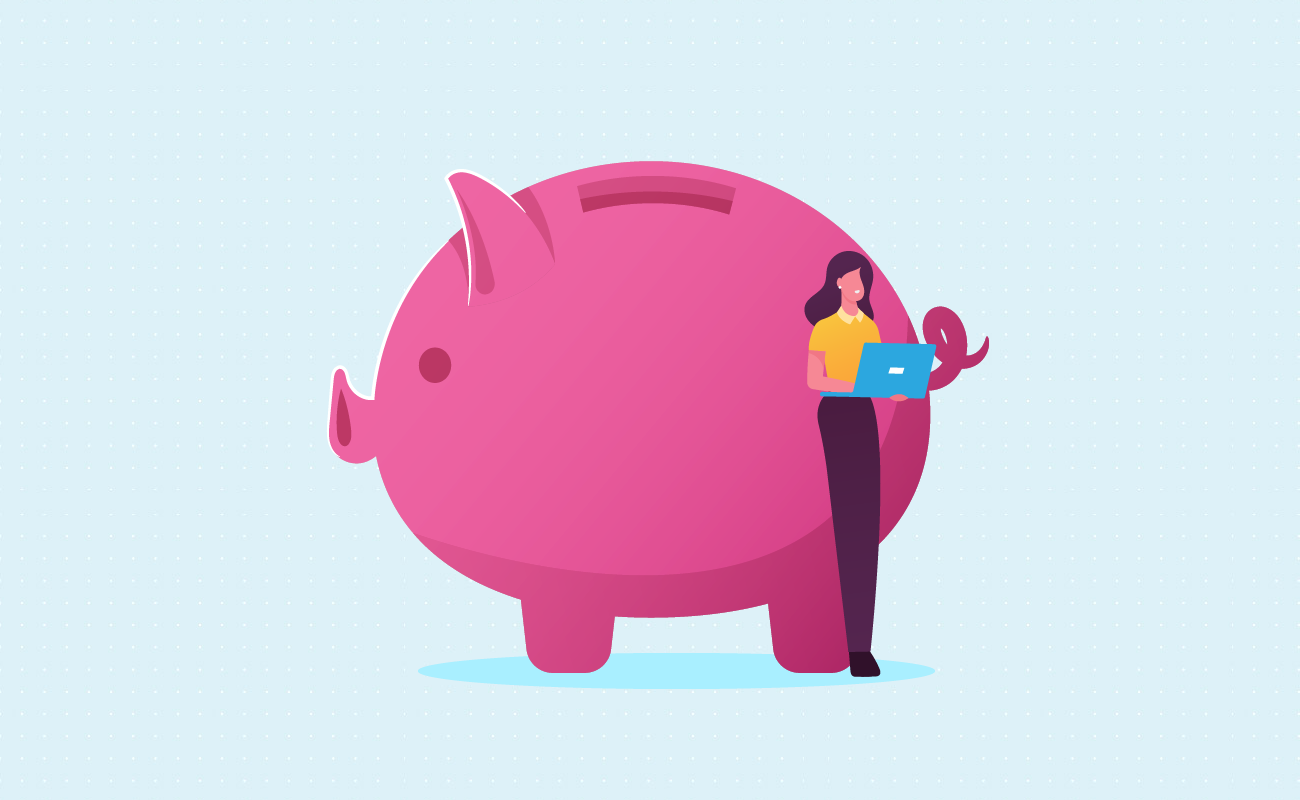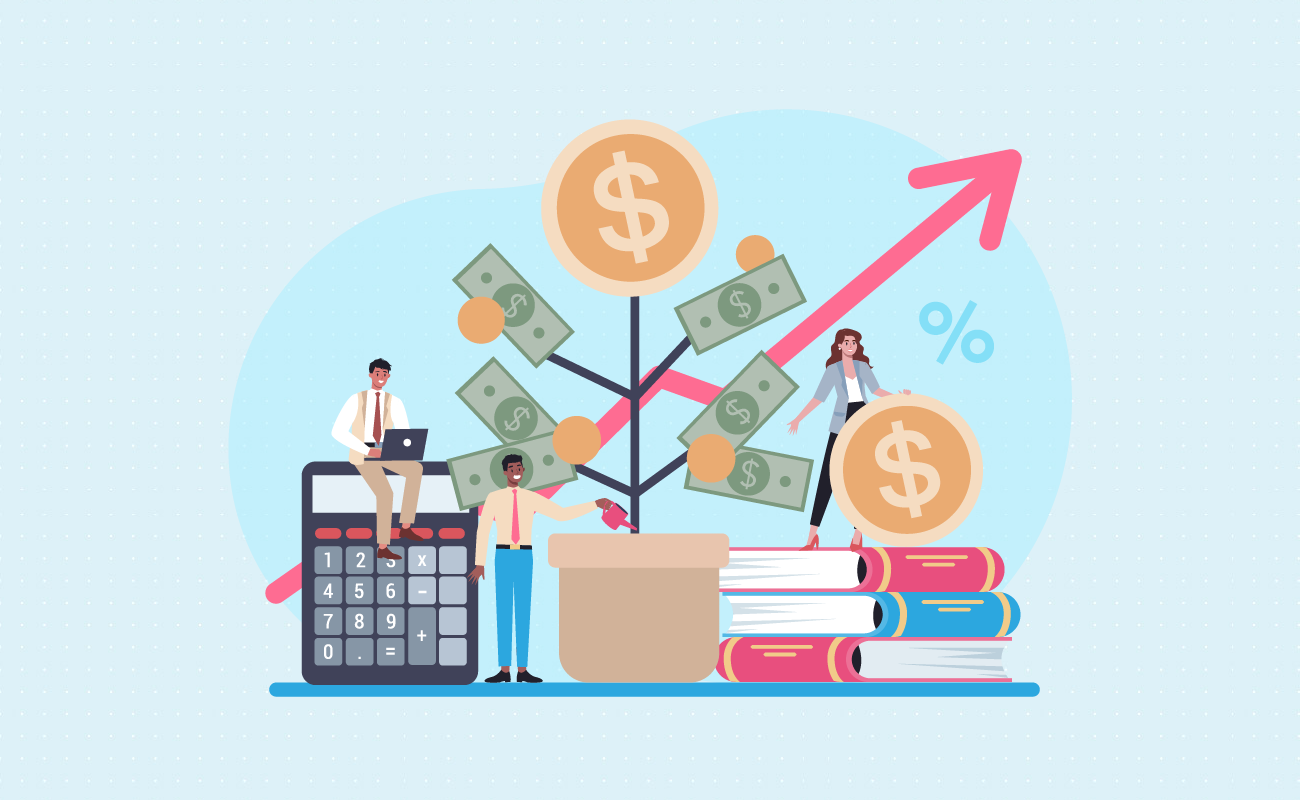 Investment RoR Calculator
Investment RoR CalculatorInvestors can use this calculator to determin the average annual rate of return on their investments even if those investments have irregular investments or withdrawals.
Instructions
Guide published by Jose Abuyuan on December 2, 2020

You worked night and day for your savings. From budgeting to better shopping decisions, a lot of work goes for that surplus. But we’re not through yet. Saving money is only the first step toward long-term financial security. The next step is to put money to work. It’s time to invest!
When you invest, your money grows at an exponential rate, provided you keep it invested over time. But not all investments and investors are the same. You’ll need to tailor your investments to match your personal goals and financial state.
Investments are a complex affair. It is easy to get confused in the terminology, especially if you haven’t invested before. Thus, it pays to know what you’re doing, in a very literal sense. Staying well informed can help you make your money go further.
Investing has become a buzzword that’s been abused to oblivion. But what does it really mean? In the broadest sense, investing means buying something that will help make you money. This can vary in different contexts. In the context of finance, it refers to making financial commitments in the hopes of making a profit. It’s using money to make more money.
Some investments involve buying an asset that grows in value over time. The house you live in is often the biggest investment you’ve made. Others are a variation on the theme of lending with interest. You lend your money to a borrower you trust. They will then use that money for a purpose and repay you with interest.

Even savings accounts are part of a long chain of investments. You trust the bank to hold onto your money. Your bankers, meanwhile, offer loans to homeowners and entrepreneurs. They use this money to buy themselves assets that generate wealth for themselves. In turn, they pay back bankers with interest, who then pay you interest.
Funding a business venture is what many people think of when they hear the word “investing.” You either agree to extend a loan to a business or buy a share of its ownership. As the business grows and makes money, the entrepreneurs pay you back with interest. Corporations offer these in the form of shares and bonds. Shares are an ownership stake in the business, while bonds are loans.
Investing your money is the key to long-term wealth generation. This way, you take a lot of the work away from building exponential wealth. You could even invest enough to provide income without needing to work. But let’s not get ahead of ourselves. The key to making this all possible is compound interest.
Interest is the fee paid for the use of your money. Deriving it can vary between asset classes. These, however, are all variations on the same fundamental calculation. Interest is the product of three main factors:
These are terms you also encounter when describing debt, and they work in reverse. Debtors want to lower the interest they owe. As the investor, you want to increase the amount of interest you receive. Altering these factors changes the interest due. Savings in a bank for instance, will make you more money if you did the following:
Thus, money-making through investing is a long-term endeavor. You must set aside a regular part of your income toward savings and investment to build wealth. Moreover, you must give your money time to make more money. Time and compounding are your greatest allies. Even modest investments can yield great returns given enough time and the right rate.
Most investments rely on compound interest (or compounding) to make their gains. This is, in essence, a way of putting reinvestment on autopilot. Compounding works by adding the interest you’ve earned to your principal. Your term is divided into compounding periods defined by a specific span of time. Each compounding period adds the interest you’ve made so far to your principal. In effect, you are earning interest from your interest.
How long each compounding period varies. Most major investments have annual compounding periods. This means that your principal grows with the interest you make each year. Others, like savings accounts and certificates of deposit, may compound each month.
The formula for future value gained through compound interest is as follows:
FV = PV x [ 1 + (i/n)]t
Where:
FV = The future value of your investments
PV = The present value or principal
i = Your annual rate
n = The number of compounding periods in a year
t = The term, in number of compounding periods
For our first example, let’s imagine you saved $15,000 in a high-yield savings account. This has a generous annual percentage yield (APY) of 2 percent. Your bank compounds monthly. Assuming you leave your money alone, it could grow all by itself. Let’s see how much money you would have after only three years:
High-Yield Savings Account (Compounds Monthly)
Principal (PV): $15,000.00
Rate (APY): 2%
Term: 3 years (36 compounding periods)
FV = $15,000.00 x [1 + (0.02/12) ] ^ 36
FV = $15,000.00 x [1 + (0.0017) ] ^ 36
FV = $15,000.00 x [1.0017] ^ 36
FV = $15,000.00 x 1.0631
FV = $15,946.50
After 3 years, you would’ve earned an extra $946.50 without any extra effort on your part. And our example is a lump sum. If you instead made constant deposits, you will speed up this process even further. And if that sounds good, imagine if you invested in assets with a higher rate of return.
Hold on there, partner. As the saying goes, there’s no such thing as a free lunch. Before you start investing, ask yourself how much of your income you are willing to risk.
Few things are ever without a catch. Investing is lucrative when all goes well. But what if it doesn’t? Murphy’s Law rules that this could be much more common than you’d like. Risk is an inevitable part of investing. It is not a question of whether you can avoid risk altogether (spoiler alert: you can’t). It’s a question of how much you can take.
Even the safest investments have at least some risks, unlikely they may be. So-called safe assets can still succumb despite their safeguards. These events are rare, however. There’s no point in being too cautious when you don’t need to. But don’t think of this as license to be reckless.
Without an understanding of risks, investing is little different from gambling. Knowing your own tolerance for risk can help take the guesswork out of investing. You’ll know exactly how cautious you need to be. The ideal investments have long-term returns that far outweigh their short-term risks.
The main risk of low-risk investments aren’t unexpected events. It’s inflation. Over time, money loses value as the money supply increases. Working people do not always notice this because their incomes grow with the prices. But they will feel the crunch on their savings. Economic disasters may come and go, but inflation is here to stay.
To preserve your money’s value, your investments must outpace the expected rate of inflation. This is especially true if you are still young and can expect a rather long time horizon. In good times, for instance, you should aim for an APY that far exceeds two percent to profit.
In most circumstances, you are likely to survive financially with a few losses. It is not advisable to be risk-averse when you don’t need to. The truth is that risk aversion has an opportunity cost. By choosing investments based only on risk, you miss out on opportunities to make great gains. You may not have lost the money you currently have, but you missed the amount you could’ve gained if you took the riskier option.

The key to successful investing is proper risk management. It’s not only a matter of reducing your risks when you invest. It’s also about deciding whether the risks you are exposed to are worth taking. The appropriate risk management strategy aims to outperform risks in the long run. With proper risk management, short-term losses will not derail your long-term financial goals.
In general, risks and rewards have a direct correlation. The riskier the investment, the higher the potential rate of return. You can also measure how worthwhile risks are based on your time horizon. Short-term monetary security, for instance, favors low-risk investments. If you want to preserve your savings, safe investments are the way to go. If you want to grow your money, pursuing riskier investments might be the better option.
The following table compares the real and nominal rates of return of four different asset classes based on a comprehensive Harvard study. The data represents the historic performance of these three asset classes over a period of 65 years (1950 and 2015).
| Asset Class | Nominal Rate of Return | Real Rate of Return |
|---|---|---|
| Bonds | 7.30% | 2.79% |
| Equity (Stocks) | 12.97% | 8.30% |
| Housing (Real Estate) | 12.27% | 7.42% |
Equity investments, which includes stocks, performed the best over the long term. However, they are also some of the riskiest assets to hold onto in the short-term. Likewise, bonds, the go-to low-risk investment, have lower returns. Stocks have a 5.51 percent advantage over them in the long run.

In economics, an asset is anything that provides some sort of benefit. In practice, it often refers to items that have value or can generate income. These can include tangible items like vehicles, equipment, or land, or intangible assets like funds and accounts. Most assets depreciate or lose value with disuse. Investment assets, meanwhile, are those that grow in value over time.
Investment assets are divided into asset classes, which are governed by the same regulations. The three traditional asset classes are equity, fixed-income securities, and money market securities. Investment professionals also include other classes of investments into the mix. These include real estate, stake in businesses, commodities, and recently, cryptocurrencies.
Many investment assets are securities. These are financial instruments that change in value and can be traded on the open market. You have the option of holding onto the security or selling it when its price changes.
These are brought together in your portfolio. The core of a typical portfolio often consists of the three main asset classes. Unconventional assets can be mixed in as needed.
While bearish times can be bad news in general, it isn’t BS for everyone. They represent an opportunity for new investors to increase their stock holdings at little cost. During bear markets, stock prices are low. This is the ideal time to buy more stocks. With the right mix of stocks, an investor can lay the groundwork for good returns during a bear market.
The savings account is often your first major investment. As its name suggests, it is first a tool to keep your money safe. Although they earn interest, they often have very low APYs. The returns you can expect from a regular savings account will be modest, even when times are good.
Note that APY on savings accounts are subject to change. It adjusts accordingly with the Federal Reserve’s changing benchmark interest rate. If your bank advertised an APY of 2%, this can go up or down depending on market conditions. For instance, when the COVID-19 crisis affected the U.S. economy, the Federal Reserve stated it will maintain its benchmark interest rate near zero until 2023. As of November 2020, the average APY you can receive from most banks is 0.05 percent.
The returns you make from a savings account can give you a leg-up if you are saving for a short-term goal. Thanks to compound interest, you can even reach these goals much sooner. The high-interest savings account is thus an excellent financial tool at your disposal.
As an investment, savings accounts are insufficient to build immense wealth. Your savings account should be for money you plan to keep liquid.
Certificates of deposit (CDs) keep a fixed amount of money for a limited term. These accounts tend to vary, but they follow the same general rules. The money can be locked anywhere between six months to five years.
There are key differences that distinguish CDs from regular savings accounts. These accounts store a fixed amount of money. You cannot add to your principal once you’ve made a lump-sum deposit. They are also illiquid. Once your money is in a CD, you cannot withdraw without incurring a penalty until it matures.
A CD can vary according to how it compounds and whether its rate changes. Fixed rate CDs keep their rate throughout its entire term. Your interest was determined the moment you signed on. Variable rate CDs, meanwhile, have floating rates that change each year. You could have a higher or lower interest payout at the end of your term. This can be advantageous when interest rates rise.
The following table outlines some of the highest APYs you can expect from CDs as of November 2020. These are compared to average figures from the Federal Deposit Insurance Corporation (FDIC):
| Term | Average Standard APY | Highest APY |
|---|---|---|
| 3 Months | 0.08% | 0.50% |
| 6 Months | 0.11% | 0.60% |
| 1 Year | 0.18% | 0.73% |
| 3 Years | 0.28% | 0.85% |
| 5 Years | 0.36% | 1.00% |
Rates should not be the only thing you look at when selecting a CD. You should also look at its compounding frequency and its pre-maturity penalties. You must examine if you can receive the payments by check or through electronic means. Some banks may even reinvest your money if you gave no further instruction on what to do afterward.
One of the key advantages of CDs is that they have low risks. Those you receive from a bank insured by the Federal government are guaranteed for up to $250,000. These apply to all the bonds you have at that bank. However, they have rather modest returns compared with other investments. These may not be enough to outpace inflation.

A bond is a debt security sold by institutions as a means of securing cash flow. They are loans you give to organizations. Businesses, cities, and the Federal government alike sell bonds to investors to bolster their liquid cash reserves. In turn, they often provide their debtors with a steady source of passive income through monthly interest payments called coupons. Upon its maturity, you receive your original principal as a lump sum. Zero coupon bonds do not give interest payments; upon maturity, they provide the interest alongside the principal.
Much like a stock, a bond represents the confidence you have in an organization’s ability to repay. You receive payments as long as the backer stays solvent, much like you would receive a dividend. Although you can hold onto the bond until maturity, you can also sell the bond for a profit.
Bonds can also be divided into their components, which can be used for distinct purposes. One part becomes a stream of regular income whereas the other is sold at a discount to its face value. The price of bonds rise and fall in opposition to the prevailing interest rates. As rates fall, bond prices rise, and vice versa.
Although bonds are usually safe, they do come with the risk of your debtors defaulting. The higher the interest rates promised, the riskier the bond is. Always check the creditworthiness of an organization before buying a bond. Because they are cash assets, however, they are also vulnerable to inflation.
Rate changes and time can also affect the payouts of bonds. Long-term bonds are sensitive to rate changes because their principal is due further into the future. Because they don’t pay interest, zero coupon bonds are more sensitive than bonds with coupons of the same length. Not only do they not yield any income, their principal is also only returned at maturation.
There are three main types of bonds, which are distinguished by the organization selling them. Each one has different risks and advantages associated with them:
Bonds are also sorted according to their maturity dates:
Bonds have been the go-to cash investment for when you want a steady, guaranteed return. These are a useful addition to your portfolio if your risk tolerance is still very low. The stability provided by a bond’s low risks can help you offset your short-term losses. As of November 2020, the expected maximum returns of the following assets are as follows:
| Bond Type | Return |
|---|---|
| Treasury Bonds (30 years) | 1.58% |
| Corporate Bonds | 2.35% |
| Municipal Bond Funds | 4.55% |
Bonds, in general, have much lower, predictable returns than more volatile stocks. Because they are a cash asset, they don’t provide as big a return in the long run. Each type of bond has their own investment advantages.
| Category | Pros | Cons |
|---|---|---|
| Treasury Bonds | Treasury bonds are guaranteed by the U.S. Federal government and do not default. | Treasury bonds are prone to inflation. These bonds also have very low rates of return. Treasury Inflation-Protected Securities (TIPS) provide some protection against declining buying power but have minuscule returns. Profit from these bonds are subject to federal income tax. |
| Corporate Bonds | Corporate bonds provide a higher rate of return compared with treasury bonds. High-risk corporate bonds sometimes (though not always) have higher payouts than municipal bonds. | Corporate bonds have a higher risk of defaulting. The higher the advertised rate, the higher the risks of default. Corporate bond interest is subject to income tax at the federal and state level. |
| Municipal Bonds | Municipal bond funds offer much higher returns than either treasury or corporate bonds. They are much less risky than corporate bonds since they are backed by a government entity. Although not free from tax obligations, they come with federal tax advantages. You can also receive state and municipal tax breaks if you receive munis from your own city. | Although rare, there is a risk that the city that issues the bond might default on their payments. |
A stock is an equity security representing a fractional stake in the business. Stockholders are, in effect, one of several co-owners of a large enterprise. When the business makes money, they make money, and vice versa.
Depending on the company’s policy, a stock can provide a dividend to its shareholders. This is a share of the company’s profits in the form of cash or equity distributed each year by the board of directors. In a good year, a company’s investors may receive a rather generous dividend. As attractive as these are, dividends are not the main draw of stock investing. Their returns are modest compared to the growth of the stock itself.
The true value of a stock lies in its ability to keep or grow its value over a long time horizon. Unlike most assets, stock is based not on the inherent value of the company’s assets. Instead, it hinges on its ability to make money. For an established company, this value would often go up over time. This makes it very resistant to inflation in the long-run.
Much of what makes stocks high-risk rests in this dependence on business performance. The performance of a business (and thus its value) can change over the course of a day. Thus, you may lose a lot of money upon buying stock because it drops in value the following day. Over time, though, a well-run company’s value rises steady over time.
There are two ways to invest in stocks. One is to simply buy stocks and hold onto it. The other is through trading. Traders buy when the price goes down and hold onto the stock until its prices rise. They often decide well in advance what percentage the stock’s prices must change before they sell or buy. The idea behind trading is to outperform long-term trends. This is distinct from day trading, where traders buy and sell every day based on daily price changes.
A skillful trader enjoys an immediate profit at the cost of more risks. The stock prices you bought might drop more in the short term and take longer to recover. Trade too frequently and you might accrue brokerage fees and capital gains taxes. Finally, trading does not perform well in the long term. Over time, people who hold onto stocks make more money.
Compiled by Standards and Poors (S&P), Dividend Aristocrats are companies that displayed consistent growth over 25 consecutive years. These guarantee a generous dividend payout and steady growth. To qualify as an aristocrat, an S&P 500 company must also meet the following criteria:
In 2020, there were 65 companies in S&P’s Dividend Aristocrat list. Companies fall in and out of the list each year. They enter the list after reporting the 25th consecutive year of constant growth. Once they report no growth, they fall out of the list, and can only return after 25 more years have passed.
An aristocrat company is one that is well-established. It is often capable of delivering guaranteed profits over the long term. While an attractive option for investors who want stable returns, these shouldn’t be the only companies in your portfolio. Forbes.com reports that between September 2010 and September 2020, the Aristocrats delivered average annual returns of 10.80 percent. They were outperformed by the S&P 500 as a whole, which yielded returns of 11.65 percent.
There are two ways you can invest in Aristocrat stocks. One option is to buy the stocks themselves. A few stocks are still within relative reach of the established average investor. If you’re tight on cash, you can instead invest in them through an ETF such as KNG or NOBL.
When investing in stocks, you have two options in buying them. The first option is the lump sum approach. You buy a lot of stocks all at once, regardless of the price. This can be an expensive option, and one that doesn’t always get you the best deals. The alternative is dollar-cost averaging. This is where you invest in smaller increments each month.
This system can work to your advantage when the markets are volatile. Each month, you buy a set number of stocks with your money. In some months, you would buy more stocks as prices go down. In others, you would buy less. This has the potential to save you a lot of money.
Suppose you had $60,000 to invest. But January opens up with a rather high price for stocks in general. Instead, you set aside a budget of $10,000 to buy stocks with. You invest this amount between January and June. Let’s assume the market plays out this way:
| Month | Amount | Stock Price | Stocks Bought |
|---|---|---|---|
| January | $10,000.00 | $450.00 | 22 |
| February | $10,000.00 | $470.00 | 21 |
| March | $10,000.00 | $420.00 | 23 |
| April | $10,000.00 | $390.00 | 25 |
| May | $10,000.00 | $400.00 | 25 |
| June | $10,000.00 | $430.00 | 23 |
| Total | $60,000.00 | 139 |
By June, you would’ve bought 139 stocks. If you bought them all in January, you’d have gotten only 133 stocks. Of course, you would’ve bought more if you invested instead in April, but you probably would not have known that. This strategy commonly works when markets are exceptionally volatile. If the stock prices were bullish, however, you might be better off buying everything in January. And this is often the case.
Studies have shown that lump-sum investing outperforms dollar-cost averaging in the long run. Remember though that conventional wisdom doesn’t apply in all situations. Sometimes, dollar-cost averaging may work better for you. The main advantage of this method lies in managing your emotional expectations. Instead of spending at once or not spending it at all, you split the difference. Thus, a sudden downturn will not put you ill at ease. This prevents you from making irrational decisions that will cripple your returns.

Lump-sum investing works better for people with less money to invest. By not distributing your funds, you are likely to get more for your money.
The other common investment people make is in real estate. It is often the biggest major investment an average person can make in their lifetime. While it contributes to your personal wealth, real estate you live in is illiquid. You can’t turn that into money until you sell it, and you probably won’t want to.
Investors with a lot of starting capital can take this a step further. By buying a secondary property, they can lease it out. At first your cash flow offloads the cost of the mortgage to the tenants. Once you’ve paid that off, though, you’re generating a passive source of income. The only real work you need to do is spend on your building’s periodic upkeep.
Often, investors plan around inflation and hope to outperform it. Real estate investors see inflation differently. The right moves can help make inflation your ally. See, when you take out a mortgage, your payments remain the same on paper. You’ve locked in this fixed amount for several years, regardless of inflation. This is usually the case when people take a fixed-rate mortgage.
When prices rise, so will your rents and revenues. Yet the mortgage payment remains the same. Instead of paying extra toward your mortgage as you would with your residence, you can instead reinvest your money elsewhere. One way to take advantage of this is by buying more real estate. If you have a good gauge of demand, you can fill that building out fast. And as long as you maintain your cash flow, debt will not be a problem. A savvy investor can build a lot of wealth through real estate this way.
Real estate isn’t the sole domain of the big investor. Real estate investment trusts (REITs) make it possible for average persons to invest in real estate without a large starting capital. These funds pool the money of several investors to buy a diverse set of properties.
Because of their costs and returns, they are quite attractive to new investors. Marketwatch reports that in the past few years, REITs have outperformed stocks. But are they worth the hype? Here’s how they stack up:

| Pros | Cons |
|---|---|
| Much like stocks, REITs give out dividends. By law, 90% of a REIT’s earnings must be given out as dividends to its investors. | Because of these high payouts, REITs often take on debt to expand their portfolios. |
| These payouts can be quite generous, resulting in immediate short-term returns. | Much like with regular real estate, they profit only as much as demand for occupancy stays high. |
| They are also more liquid than traditional real estate. Rather than go through the hassle of selling a building, you simply sell your shares if you want to cash out. | The price of shares rise and fall with property value. It’s hard to sell at a good price when property values plummet. |
| A REIT also lets you diversify your real estate holdings for less cost. Rather than buying one property, you invested in several. | REITs do not always qualify for 15% tax rates. These are subject to ordinary income tax. |
| You do not have to manage the cost of the buildings directly. | If interest rates rise, your profits will drop. More money will go to paying mortgages than paying your dividends |
| Moreover, real estate and stocks seldom move lockstep. Having REITs diversifies your portfolio and helps it perform well even in a bear market. | You don’t get a lot of capital appreciation by investing in a REIT. |
While investing in REITs can help diversify your portfolio, the individual REIT is not diverse by itself. Most REITs direct the majority of their investments in a single property type. One could, for instance, focus on hotels and leisure accommodations. Others may concentrate instead on commercial real estate or multifamily apartment buildings.
This brings with it risks that are tied to market fluctuations. A REIT may underperform because the properties it invested in are not in demand. Moreover, the impact of sudden market downturns can be catastrophic, even in the short-term. The travel restrictions brought about by the COVID-19 pandemic, for instance, have dealt a devastating blow on the hotel industry. REITs that specialize in hotels will feel the crunch.

Talk to a tax professional before investing in a REIT. It’s always important to compare your tax burdens with your potential returns.
Not everyone can afford to invest in many different types of assets on their own. You’ll need a large amount of savings to buy a stock from every company in the S&P 500, for instance. Buying assets individually may not leave you with a lot of leeway to diversify. You may not have enough money left behind for corporate bonds and REITs after buying stocks.
To circumvent these limitations, many small investors instead invest in a pooled fund. Much like other securities, these funds can be held or traded on the discretion of the investor. They provide investors with an easy and inexpensive way to diversify their portfolios. These hold other advantages to investing in individual assets. These are managed by professional companies who manage the fund on your behalf.
There are two main types: mutual funds and exchange-traded funds (ETFs). Both of these funds act as baskets for a communal pool of assets. The key difference between them lies in their ownership. In an ETF, the company that manages the fund owns the assets on behalf of the investors. The assets in a mutual fund, meanwhile, are owned by all its investors.
Pooled funds come in four variants, depending on the type of assets they invest in.
Here are other key differences between the two:
| ETF | Mutual Fund | |
|---|---|---|
| Management | Most ETFs are passive and peg their performance to a specific index. Others are actively managed by fund managers. | Most mutual funds are supervised by fund managers. |
| Trading | ETFs can be bought and sold like stocks on the market at any time. | Mutual funds are bought once a day. |
| Price Changes | ETFs can vary in price over the course of a day. How much your share will cost you will differ from those of other investors. | All investors who buy mutual fund shares on the same day get the same price. |
| Investment Cost | ETFs have no minimum initial investment and are bought as whole shares. You can buy a whole share at market price. | Mutual funds have a dollar-value minimum investment. These do not always correspond to the price of shares. Thus, you can often buy fractional shares. |
| Other Costs | ETFs have implicit and explicit costs. Explicit costs include operating expenses and trading commissions. Implicit costs include the difference between the selling and buying price of the ETF. | Although mutual funds can be bought without commissions, they have other associated costs. These include sales loads and redemption fees. |
| Taxation | ETFs have lower capital gains taxes. | If your fund manager trades frequently, you may have higher capital gains taxes. |
An ETF works better for active traders, who can sell and buy these shares with little trouble. They also provide benefits for people who want to keep their investments tax-efficient. Mutual funds, meanwhile, are better suited for more traditional investors. Want to make the most of your money through dollar-cost averaging? The mutual fund has it covered. An actively managed mutual fund is also a good deal if you enter risky markets like high-yield bonds.
Funds can also come in open- and close-ended versions. Most mutual funds and ETFs are open-ended funds, which have an unlimited number of shares. Close-ended funds, meanwhile, have a finite number of shares. Its price will not affect the value of the assets.
Close-ended funds are more volatile than their open-ended counterparts. Too often, their share prices may surpass that of the value of their assets. They are also far more expensive. All close-ended funds are actively managed and can cost up to 1 percent a year. With this expense and risk, however, comes resilience and profit. Studies also show that close-ended funds outperform open-ended ones over the long term.
An open-ended fund allows investors to put more money in when the prices of assets go up. For instance, when gold prices go up, investors will put more money into precious metals ETFs like GLD. This is desirable when things are going well. But when things go cold, the fund is forced to sell their assets to pay the investors. This isn’t much of an issue if the assets invested were liquid, but illiquid assets are a problem. Investors who stay might experience a capital loss as other investors pull out.
This does not happen with close-ended funds. Although the price of their shares may fall, they will not lock in any of your losses when other investors leave. If security is your main concern, a close-ended fund is the right choice. You can also manage your risks by investing in open-ended funds that focus on mostly-liquid assets.
There is no one specific investing strategy that works for everyone at the same time. Some assets perform better than others at any given time. There isn’t any real way to predict their performance in the short and long term. To hedge against the risks of uncertainty, investors rely on diversification.
Each type of investment has its own benefits and drawbacks. Thus, no single asset should comprise the entirety of your savings portfolio. Diversification works on several levels. You can diversify by buying stocks, bonds, and other investment types. You can go further by buying stocks from companies in different sectors. What affects one industry or asset class doesn’t always affect another. Thus, when one asset underperforms, the others can pick up the slack.
In the past two decades, the world economy has faced several major economic downturns. The Late 2000s Financial Crisis and the COVID-19 pandemic had effects that rival the 1930s Great Depression. But outside these (often temporary) events, investments follow a more-or-less predictable pattern. How you should invest is dependent on whether you can afford to wait out the bad times.
There are two basic strategies when planning your portfolio. Aggressive investing is where you choose riskier, high-yield assets. This is ideal when you have plenty of money to invest and a lot of time to wait out market fluctuations. Conservative investing plays it safe with low-yield, low-risk assets. It works best when you don’t have a lot of money or time at your disposal.
How, then, do you gauge your risk tolerance? There are two main factors to consider: age and financial status. Leveraging both is the key to maximizing your returns regardless of your current financial state.
Of the two, age gets most of the discussion because it is easier to understand. Thanks to compound interest, investment favors long-term commitments of several years or more. As it stands, the sooner you start, the more money you can make. Time horizons also lets you hedge against short-term volatility. If you start young, you can invest on stocks and need not worry about short-term variability. So the saying goes, the best time to invest was yesterday. The second best is today.
Based on age alone, you can gauge your ideal asset allocation through a simple formula. Subtract your current age from 110 to figure out the percentage of your portfolio that can go to stocks. The rest can be allocated to bonds and other investments. If you are 25, for instance, here is your ideal allocation based on age:
= 110 – 25
= 75
Going by this rule, younger people can have a more aggressive portfolio. Meanwhile, older adults must choose a more conservative approach. But that’s not how it always pans out. You need money to make money. Young adults might have time on their side, but they wouldn’t have a lot of cash flow to take advantage of that.
Entry-level salaries and debts mean that young adults can’t invest as aggressively. One study suggested that financial status has a greater influence on risk tolerance. Often most young adults eschew investing outside a savings account. If they do invest, they may instead benefit from a conservative investment strategy. Meanwhile, established adults can adopt an aggressive investment strategy well into old age.
It often isn’t worthwhile to invest your money when you’re deep in debt. You don’t have enough risk tolerance to invest in stocks in this state. Instead, use your money to pay extra toward your debts. The amount you save this way is often greater than what you would have made in the short term.
Asset allocation is the percentage you invest in a specific asset class. These are drawn from established benchmarks based on risk tolerance and investment goals. In our first example, you dedicated a greater amount toward stocks at 75 percent. The rest, which include bonds, make 25 percent.
The benchmarks for each asset class will vary over time. No one person’s benchmarks are exactly the same as others. But we can make general rules based on common goals and typical risk tolerances. If you have a lower risk tolerance, adjust your percentages. In our example, you can instead allot 60 percent of your portfolio to stocks and 40 to low-risk assets.
Reallocating your assets is as simple as buying and selling assets until you reach the desired ratio. If you found that you own more stocks, either buy more bonds or sell the stocks.

Be careful of the tax consequences of reallocating, though. Talk to a tax professional and see what your ideal strategy should be.
Asset allocations are described as overweight or underweight. These labels are based on how much they vary from the benchmark. If your benchmark is 60:40 in favor of stocks, here’s where you’ll be:
Many people don’t pay close attention to their asset allocation. Thus, they go overweight or underweight relative to their ideal benchmark. This can be quite risky. Thus, you must rebalance your portfolio to better match your benchmark. For instance, as your career progresses, you have more free cash to invest. Your risk tolerance grows and you can invest more on stocks. Likewise, if you hit a rough patch, you might consider a conservative strategy. Move your portfolio toward bonds and other secure investments.
Sometimes, people go overweight on purpose. Taking on a more aggressive investment strategy, for instance, promises better long-term returns. The daredevil investor will go overweight on stocks and underweight on bonds.

This also applies when you choose one industry to represent most of your stocks. A diversified portfolio draws stocks from many sectors. An overweight one, meanwhile, will draw a greater number of stocks from one industry. For instance, some people are confident in the growth of the tech industry. They may choose stocks from this sector on purpose. Overweighting in one industry provides generous returns while the market favors that industry.
The terms are also used by financial analysts to compare companies’ short-term performances. An overweight company will perform better than the rest of the other companies in its sector. Likewise, an underweight company will underperform. When an analyst believes a stock is overweight, it might be in your best interest to buy more of it. This can help you capitalize on the growth of these companies in your portfolio.
This level of micromanagement has its downsides. The gains you make this way are often short-term. Like all other forms of trading, there is a risk that the pattern of their performance might not hold in the long run. To overweight your portfolio on purpose makes it less diverse. This will make you prone to big shifts in asset prices. By depending too much on one company, you could be left holding the bag.
An individual stock is often quite expensive, especially if they belong to an established big-name company. As of November 2020, a single stock of Google’s parent company, Alphabet Inc., can cost up to $1,500. That’s quite an entry barrier for the average investor.
Fortunately, you have the option of buying fractional shares of a whole stock, which is a smaller percentage of a single share. These started to grow in popularity between 2019 and 2020. At the time, investing companies like Fidelity and Charles Schwab began selling slices of big-name stocks to entry-level investors. Stocks aren’t the only securities that come in fractional shares. Mutual Funds can also come in fractional segments.
The main market for fractional shares are younger investors, and with good reason. Their low costs make them an attractive option for entry-level investing. Introducing stock slices can bring some much needed diversity to a modest portfolio.
As attractive as fractional shares are, they come with disadvantages. There aren’t a lot of companies that offer their shares in fractions. Because their stake is minuscule, fractional shareholders don’t get much from a company. They can’t vote on company policy and receive much smaller dividends.
Fractional shares are also less liquid than whole shares. Most sellers prefer to wait until they’ve accumulated enough for a single share. Meanwhile, some shares are hard to offload because of a lack of demand. You can’t often trade fractional shares. Instead, your broker might simply buy them back and give you cash. This can come with tax consequences as your shares may have grown in value.

Fractional shares aren’t quite worth investing if they come with extra fees. These can eat into what little profit you’ve gained. Be sure to know about any fees that apply before investing.

Running a business is hard, and staying in business even harder. As an entrepreneur, the odds are stacked against you from day one. You must contend with the workaday challenge of ensuring the business stays in the black. In the time before your business finds its legs, you might wonder if you even have money to spare to invest.
As the owner of a small to medium-scale enterprise (SME), your rykes for investing are different. You must invest in other assets, of course, but you must also consider investing on your own. The key is to know how much of your income should go to investing on your own venture.
The first thing to remember is that, as an entrepreneur, your risk profile is different. Unlike most people your age, you can’t take the same cavalier attitude toward investment. The consequences of being your own boss is that your cash flow is not guaranteed. Thus, an entrepreneur’s ideal portfolio is far more conservative. A good mix for an established entrepreneur aged 35 years would be a 50:50 ratio of stocks and bonds. Meanwhile, an employee of the same age and income bracket would choose a more aggressive ratio of 75:25 in favor of stocks.
As an entrepreneur, you already have a major big-risk investment: your own business. At least part of your own earnings should be reinvested into your venture. The first of these should be a safety net fund. This will help tide your business over in case you hit a lean month. Here are a few other suggestions:
You, your employees, and your loyal customers will appreciate the right improvements. And with this added comfort comes greater productivity and profits. Examine every major business expense before committing your hard-earned money. Compare the future returns of your investment to its present value.

An investment in your own business that pays well is employee retention. Turnovers are costly affairs. The process of hiring a replacement will cost six times the monthly salary of the worker you lost. Make an environment and compensation structure that makes good employees want to stay.
There are two ways you can invest in your own SME. The most common way to do so is through equity investment. This refers to buying a larger stake in your own company (i.e. buy out a greater share of it from your co-investors). Another is to provide it with a loan, which can be converted into equity. You can mix and match both as needed.
| Category | Pros | Cons |
|---|---|---|
| Equity Investment | You gain a bigger stake in your business and a bigger share of the profit. A larger stake translates to control of your business’ policy. You get a bigger say on how your business is run. | Equity in a business is illiquid. You cannot cash out your earnings as needed. |
| Founder Loan | You know the exact risks and rewards of your own business. Your loan can be tailored to your business’ ability to repay. You get a steady stream of liquid cash. You have the option of converting this into equity. | Unless you convert your debt to equity, you usually cannot have a bigger stake in your enterprise. |
To mitigate risk, take a page from the venture capital playbook and invest in tranches. Tranches divide your reinvestment funds into two or more segments. These are based on the company’s needs and the development milestones it has accomplished so far. You provide one tranche of funds to expand the company, and another if that expansion proves profitable.
One way to effectively invest in tranches is to make many small bets on different marketing ideas, distribution channels, and attempts at innovation. Make the bets or position sizes small enough that you live to fight another day. And then track market perofrmance and feedback to look for clues something is working. If something takes off then invest more aggressively into a particular idea or method when it has shown traction. To give themselves maximum runway, many entrepreneurs do consulting or maintain a regular job while avoiding debt, so they get to learn and experiment on nights and weekends until something works. For a person who is just starting out having a low living cost gives them maximum runway.
Don’t ignore diversification altogether. Investing as an entrepreneur is a balancing act. The risk that comes with investing only in your business is immense. Even if you think you know your industry, it may not be enough to outperform the S&P. Moreover, if your business shutters, your investments could go down with it. Make sure to leave room in your budget for savings and investments elsewhere.

In the 1950s, central banks served as a way to counterbalance volatile markets. Today, these same banks have taken a more lax approach. Low rates prevailed to encourage investing and reduce the price of imports. These also encouraged major corporations to borrow more money to fuel growth. Low rates, after all, mean low interest payments.
This has had many consequences for how people invest. Because the rates were so low, government bonds were easy to buy. The low rates meant that they were easy to buy and easy to sell. Bonds provided a predictable, guaranteed return. Thus, they were seen as a safe investment, a good counter to more volatile stocks.
Today’s government bonds aren’t very lucrative. With such low returns, they might not be as suited to their purpose as reliable investments. And if rates were to rise again, they would be unprofitable.
This has repercussions for conservative investors. In 2020, analysts like Wharton’s Jeremy Siegel predicted the end of the treasury bond’s place in the portfolio. In the wake of the COVID-19 crisis, the Federal Reserve might start increasing rates. Corporations may also choose to drop the bonds they’ve held. The resulting glut in government bonds can erase any utility they had as an investment.
As an alternative, investors may turn to corporate and muni bonds to fill the same need. Although not without their risks, they do provide much higher APYs than their Federal counterparts. Another proposed alternative are Dividend Aristocrat stocks. The steady dividend returns can provide the same stability that treasury bonds once offered.
The first and most important lesson in investing is this: do not touch the capital. Keep your investments and cash savings in distinct assets. The longer you keep reinvesting your money, the more its value grows. Only attempt to liquidate investments when you are in dire need. Money you expect to spend, such as an emergency fund, should be placed in a high-yield savings account.
The money you invest should be the cash you are comfortable putting away. Look at your expenses closely before deciding how much to set aside for investing. For instance, you might still need to put away more money for emergencies. You may need to focus on managing and eliminating your debts. This will not leave you with a lot to build up a portfolio. While you shouldn’t put off investing forever, you can delay it for the pressing matters of today.
An honest examination of your finances is the first step toward gauging your risks. Doing so will help you choose the appropriate allocation of assets for your needs. You may find a conservative strategy enough to preserve your savings against inflation. Knowing your budget will also help you identify the right type of investments to invest in. While you may not have enough saved to buy full stocks, you can invest in funds with fractional stocks.
Gauging your financial status will also help you devise strategies to manage taxes. Many established earners, for instance, put their money in tax-deferred investment accounts such as traditional 401(k) and individual retirement accounts (IRAs). These investors expect lower taxes on retirement, thus putting their investments at an advantage. Lower-income investors, meanwhile, might expect to make more money in the future. To preserve their earnings, they can instead invest post-tax dollars in tax-exempt Roth 401(k) and IRAs.
Capital gains taxes are an important thing to consider when investing. The strategy at hand favors holding over investing. Assets owned for a year or longer pay lower long term capital gains taxes when they are sold. Traders, meanwhile, may face steep short-term capital gains taxes. These can cut deep into any profits they make.
Because they trade frequently, mutual funds tend to have higher capital gains tax rate. To avoid extraneous capital gains taxes, consider investing instead in ETFs.
Don’t think that you’re done once you’ve applied your initial investment strategy. Your needs will change as you grow older. Newfound prosperity down the line might make an aggressive investment strategy more tenable. You’d also want to shift gears as retirement approaches. Be prepared to rethink your investment game plan as time goes by.
Investing is the key toward long-term financial security. Having enough money invested should be one of your long-term financial goals.
Want to find out how long it’ll take to save up for your initial investment? Check out our savings goal timeline calculator.
Jose Abuyuan is a web content writer, fictionist, and digital artist hailing from Las Piñas City. He is a graduate of Communication and Media Studies at San Beda College Alabang, who took his internship in the weekly news magazine the Philippines Graphic. He has authored works professionally for over a decade.